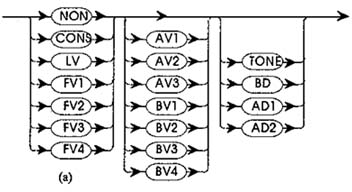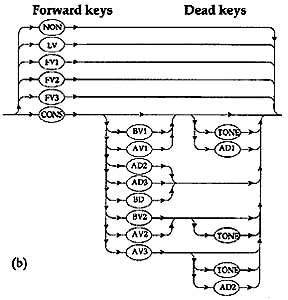3. The Ketmanee Layout - แป้นแบบเกษมณี

Figure 1. The Ketmanee Layout
4. Pattajoti's Research - ผลงานวิจัยของสฤษดิ์ ปัตตะโชติ
- load imbalance : average of 30% load to the left hand and 70% to the right hand;
- the little finger of the right hand takes 19% of Keystrokes, while the left index which is the strongest finger takes only 16% load ; and
- the typical finger movements were apparently too far from the home positions since there are some characters being placed on the top row.
| LEFT HAND | RIGHT HAND | |||||||||
|---|---|---|---|---|---|---|---|---|---|---|
| little | ring | middle | index | thumb | thumb | index | middle | ring | little | |
| normal | .00128 | .00140 | .00270 | .00799 | - | - | .03022 | .00612 | .00516 | .00722 |
| shifted | .00796 | .05518 | .06948 | .15984 | - | - | .18198 | .17164 | .11056 | .18184 |
| TOTAL | .00924 | .05658 | .07218 | .16783 | (space bar) | .21220 | .17776 | .11572 | .18870 | |
| TOTAL | .30583 | .69438 | ||||||||
- to equalise the workloads among both hands, possibly in alternation when typing;
- to have the stronger finger do the harder job; and
- to minimise the finger / hand total travelling distance.

Figure 2. The Pattajoti Layout.
| LEFT HAND | RIGHT HAND | |||||||||
|---|---|---|---|---|---|---|---|---|---|---|
| little | ring | middle | index | thumb | thumb | index | middle | ring | little | |
| Ketmanee | .00924 | .05658 | .07218 | .16783 | (space bar) | .21220 | .17776 | .11572 | .18870 | |
| Pattajoti | .05200 | .06900 | .11200 | .23300 | (space bar) | .24500 | .13500 | .08400 | .06870 | |
| TOTAL | .4600 | .53270 | ||||||||

Figure 3. Finger load comparison between Ketmanee and Pattajoti.
7. Implementation of the Pattajoti Standard
8. TISI Standards for Computer Keyboards

Figure 4 TIS 820-2531
(shaded keys are WTT 2.0 extensions for TIS 820-2536)
| 1. CTRL | control characters (corresponds to ASCII control characters and delete); |
|---|---|
| 2. NON | non-composible characters (all English alphabets and TIS 620-2533 punctuations such as paiyannoi (ฯ) , bath-sign (฿) , maiyamok (ๆ), khomut ( |
| 3. CONS | Thai consonants, consisting of the forty-four consonants of the Thai alphabets ; |
| 4. LV | leading vowels , consist of five symbols: เ แ โ ใ ไ ; |
| 5. FV1 | following vowels type 1 , consist of อะ อา อำ; |
| 6. FV2 | following vowels type 2 , consist of lakkhangyao ( ๅ ); |
| 7. FV3 | following vowels type 3, consist of ฤ ฦ ; |
| 8. BV1 | below vowel type 1, sara-u ( อุ ); |
| 9. BV2 | below vowel type 2, sara-uu ( อู ); |
| 10. BD | below diacritic (underdot), pinthu ( . ); |
| 11.TONE | the four tonemark : อ่ อ้ อ๊ อ๋ ; |
| 12. AD1 | above diacritics type 1, consist of nikhahit ( อํ ) and thanthakhat ( อ์ ); |
| 13. AD2 | above diacritic type 2, maitaikhu ( อ็ ); |
| 14. AD3 | above diacritic type 3, yamakkan ( |
| 15. AV1 | above vowel type 1, sara-i ( อิ ); |
| 16. AV2 | above vowels type 2, consist of mai han-akat ( อั )and sara-ue ( อึ ); |
| 17. AV3 | above vowels type 3, consist of sara-ee ( อี ) and sara-uee ( อื ); |


Fig. (a) basic checking.--------------------- Fig. (b) vigorous checking.

Figure 6. Example of Thai Text.
 (one base-line character plus one below-vowel and one above-vowel ), which violate the flow of Figure 5b, are never allowed. The only exception for such a violation is probably only for a deliberate explanation to such a thing, where input checking mechanism must be turned off before it can be done!
(one base-line character plus one below-vowel and one above-vowel ), which violate the flow of Figure 5b, are never allowed. The only exception for such a violation is probably only for a deliberate explanation to such a thing, where input checking mechanism must be turned off before it can be done!
11. Bibliography (All references are in Thai).
- Phraya Uphakit Silapasan [1918]: Thai Germmar.(อำมาตย์เอก พระยาอุปกิตศิลปสาร "หลักภาษาไทย -- อักขรวิธี วจีภาค วากยสัมพันธ์ ฉันทลักษณ์ " พ.ศ. ๒๔๖๑)
- Pattajoti, Sarit [1966]: " The Evolution of the Typewriter" , National Research Council, The Office of the Prime Minister, 4 November 1966. (สฤษดิ์ ปัตตะโชติ "วิวัฒนาการของเครื่องพิมพ์ดีด" สภาวิจัยแห่งชาติ สำนักนายกรัฐมนตรี 4 พฤศจิกายน ๒๕๐๙ )
- Pattajoti, Sarit [ca. 1966]: " A New Keyboard Layout System" (research final report) , National Research Council, The Office of the Prime Minister , no date. (สฤษดิ์ ปัตตะโชติ "รายงานผลการวิจัยระบบการวางแป้นพิมพ์ดีดใหม่" สภาวิจัยแห่งชาติ สำนักนายกรัฐมาตรี ไม่มีวันที่พิมพ์)
- Pattajoti , Sarit [ca. 1967]: " Thai Typewriter Practicing Manual" , The Royal Irrigation Department, no date.(สฤษดิ์ ปัตตะโชติ " ตำราพิมพ์ดีดภาษาไทย แบบ ปัตตะโชติ" อภินันทนาการจากกรมชลประทาน ไม่มีปีที่พิมพ์)
- Panyalak, Chawalit [1970]: " The Typewriter Keyboard" Wattayasan paritat, Vol.21, No. 27, 20 July 1970. (ชวลิต ปัญญาลักษณ์ "แป้นอักษรพิมพ์ดีด" วิทยาสารปริทัศน์ ปีที่ ๑ ฉบับที่ ๗ , ๒๐ กรกฎาคม ๒๕๑๓)
- Natsiri, Borwornwit [1977]: "Thai-English Typewriter" , a Master Thesis on Industrial Arts, Faculty of Architecture, King Monkut Institute of Technology at Lad Krabang,1977. (บวรวิชญ์ นิติสิริ " เครื่องพิมพ์ดีดไทยอังกฤษ" วิทยานิพนธ์หลักสูตรสถาปัตยกรรมศาสตร์บัณฑิต ภาควิชาศิลปอุตสาหการ คณะสถาปัตยกรรมศาสตร์ สถาบันเทคโนโลยีพระจอมเกล้า วิทยาเขตเจ้าคุณทหารลาดกระบัง ๒๕๒๐)
- Pattarakan, Thanakan[1986]: " A Modern Thai Keyboard " , Science, Vol.40 ,No. 9 , September 1986. (ธนกาญจน์ ภัทรากาญจน์ " แป้นพิมพ์ดีดภาษาไทยยุคใหม่" วิทยาศาสตร์ ปีที่ ๔๐ ฉบับที่ ๙ กันยายน ๒๕๒๙)
- Koanantakool, Thaweesak and TAPIC [1991]: " Computers and the Thai Language" , A Draft Proposal WTT 2.0 Standards, and a reprint of existing TISI standards on IT, NECTEC, October 1991. (ทวีศักดิ์ กออนันตกูล และ คณะทำงานร่างข้อกำหนดร่วมเพื่อการเขียนโปรแกรมซึ่งแสดงผลเป็นภาษาไทย "คอมพิวเตอร์กับภาษาไทย" ศูนย์เทคโนโลยีเล็กทรอนิกส์และคอมพิวเตอร์แห่งชาติ ตุลาคม ๒๕๓๔)
- Chanawangsa, Somseen [1993]: private communication. (สมศีล ฌานวังศะ การติดต่อส่วนตัว พ.ศ. ๒๕๓๖)
 ) , fongman ( ๐ ) ,angkhankhu (ฯl ), and numerals (๐ ๑ ๒ ๓ ๔ ๕ ๖ ๗ ๘ ๙) ;
) , fongman ( ๐ ) ,angkhankhu (ฯl ), and numerals (๐ ๑ ๒ ๓ ๔ ๕ ๖ ๗ ๘ ๙) ; );
);